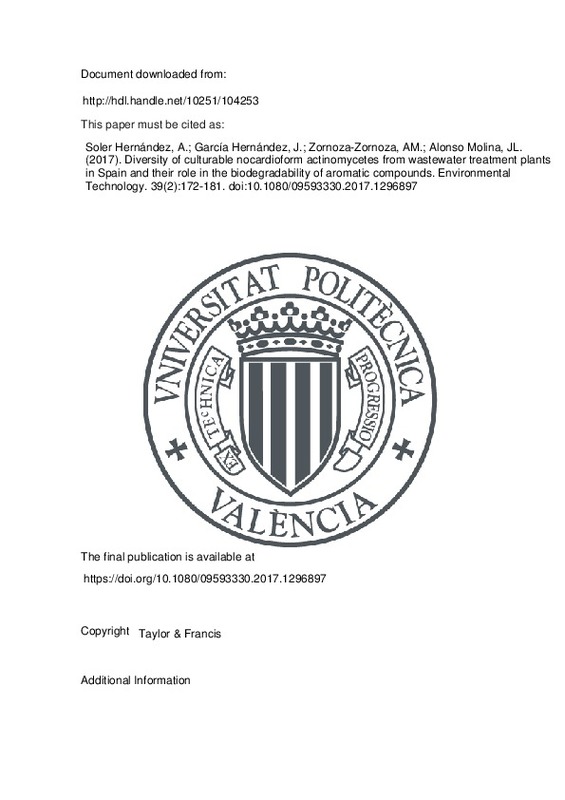JavaScript is disabled for your browser. Some features of this site may not work without it.
Buscar en RiuNet
Listar
Mi cuenta
Estadísticas
Ayuda RiuNet
Admin. UPV
Diversity of culturable nocardioform actinomycetes from wastewater treatment plants in Spain and their role in the biodegradability of aromatic compounds
Mostrar el registro sencillo del ítem
Ficheros en el ítem
| dc.contributor.author | Soler Hernández, Albert
|
es_ES |
| dc.contributor.author | García Hernández, Jorge
|
es_ES |
| dc.contributor.author | Zornoza-Zornoza, Andrés Miguel
|
es_ES |
| dc.contributor.author | Alonso Molina, José Luís
|
es_ES |
| dc.date.accessioned | 2018-06-18T04:25:33Z | |
| dc.date.available | 2018-06-18T04:25:33Z | |
| dc.date.issued | 2017 | es_ES |
| dc.identifier.issn | 0959-3330 | es_ES |
| dc.identifier.uri | http://hdl.handle.net/10251/104253 | |
| dc.description.abstract | [EN] Currently, municipal and industrial wastewater treatment plants (WWTPs) are mainly focusing on reduction of biological oxygen demand and on the removal of nutrients. However, there are microorganisms that interfere with the process. In this environment, there is a large diversity of microorganisms that have not been studied in detail and that could provide real and practical solutions to the foaming problems. Among such microorganisms, Gram-positive actinomycete bacteria are of special interest because they are known for producing secondary metabolites as well as chemically diverse compounds and for their capacity to degrade recalcitrant pollutants. Three different media were chosen to isolate actinomycetes from 28 WWTPs in Spain. A total of 189 activated sludge samples were collected; 126 strains were isolated and identified to belong to 1 suborder, i.e. Corynebacterineae, and 7 genera, i.e. Corynebacterium, Dietzia, Gordonia, Mycobacterium, Rhodococcus, Tsukamurella and Williamsia. Furthermore, 71 strains were capable of biodegrading at least 1 aromatic product, and that 27 of them amplified for catA gene. The results of this research help us understand the complexity of the foam-forming microbial populations in Spain and it shows that WWTPs can be a good source of microorganisms that can degrade phenol or naphthalene. | es_ES |
| dc.description.sponsorship | This work was supported by grants from Entidad Publica de Saneamiento de Aguas Residuales (EPSAR) de la Comunitat Valenciana. | en_EN |
| dc.language | Inglés | es_ES |
| dc.publisher | Taylor & Francis | es_ES |
| dc.relation.ispartof | Environmental Technology | es_ES |
| dc.rights | Reserva de todos los derechos | es_ES |
| dc.subject | Activated sludge | es_ES |
| dc.subject | Mycolata | es_ES |
| dc.subject | 16S rRNA gene sequencing | es_ES |
| dc.subject | Phenol and naphthalene biodegradation | es_ES |
| dc.subject | Wastewater treatment plants | es_ES |
| dc.subject.classification | MICROBIOLOGIA | es_ES |
| dc.title | Diversity of culturable nocardioform actinomycetes from wastewater treatment plants in Spain and their role in the biodegradability of aromatic compounds | es_ES |
| dc.type | Artículo | es_ES |
| dc.identifier.doi | 10.1080/09593330.2017.1296897 | es_ES |
| dc.rights.accessRights | Abierto | es_ES |
| dc.contributor.affiliation | Universitat Politècnica de València. Departamento de Biotecnología - Departament de Biotecnologia | es_ES |
| dc.contributor.affiliation | Universitat Politècnica de València. Instituto Universitario de Ingeniería del Agua y del Medio Ambiente - Institut Universitari d'Enginyeria de l'Aigua i Medi Ambient | es_ES |
| dc.description.bibliographicCitation | Soler Hernández, A.; García Hernández, J.; Zornoza-Zornoza, AM.; Alonso Molina, JL. (2017). Diversity of culturable nocardioform actinomycetes from wastewater treatment plants in Spain and their role in the biodegradability of aromatic compounds. Environmental Technology. 39(2):172-181. https://doi.org/10.1080/09593330.2017.1296897 | es_ES |
| dc.description.accrualMethod | S | es_ES |
| dc.relation.publisherversion | https://doi.org/10.1080/09593330.2017.1296897 | es_ES |
| dc.description.upvformatpinicio | 172 | es_ES |
| dc.description.upvformatpfin | 181 | es_ES |
| dc.type.version | info:eu-repo/semantics/publishedVersion | es_ES |
| dc.description.volume | 39 | es_ES |
| dc.description.issue | 2 | es_ES |
| dc.relation.pasarela | S\326700 | es_ES |
| dc.contributor.funder | Entitat Pública de Sanejament d'Aigües Residuals de la Comunitat Valenciana |







![[Cerrado]](/themes/UPV/images/candado.png)

